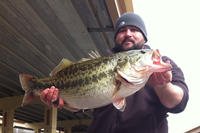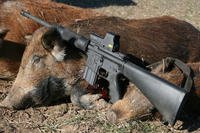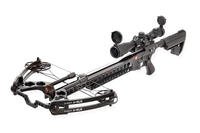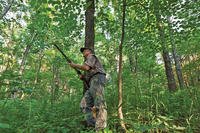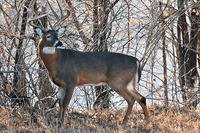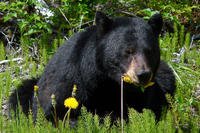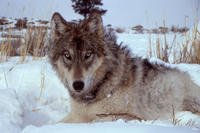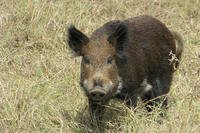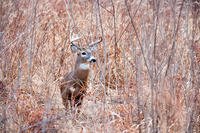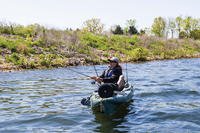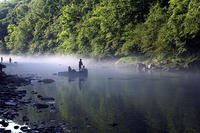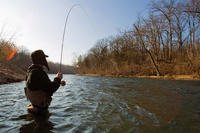Who says you have to freeze your petunias off to get in on some red-hot goose hunting? Today some of the best hunting of the year is found in the shorts-and-T-shirt weather of late summer.
by David Hart
Goose hunting doesn't have to be a frigid affair — at least not since federal waterfowl managers opened a season on what are known as resident geese nearly 20 years ago. Instead of three layers of insulated clothes, a pocket full of hand warmers and a Thermos of steaming coffee, you'll be plenty comfortable in a T-shirt and even shorts. There's a good chance you'll be reaching for a cold bottle of water soon after that first flock of giant Canadas tries to settle in among your decoys. Resident goose seasons take place in September, often opening on the first day of the month. It's hot alright, but so is the action.
Despite the unusual conditions — at least from a waterfowler's perspective — early-season resident goose hunts can be some of the most enjoyable and productive outings you'll ever experience. Aside from the fact that you won't be too cold to shoulder your shotgun, you'll see plenty of birds — if, of course, you do your homework first — and you'll enjoy the highest bag limits on Canada geese all season. In most states, hunters can take five birds per day.
The resident goose hunting phenomenon started when Canada goose numbers soared from a tolerable level to what essentially became an epidemic in the early 1980s. What was once a relatively rare and even welcome sight at urban parks and farm ponds grew into a pounding headache for wildlife managers, who imposed the September season so hunters didn't inadvertently take migrant Canada geese.
"The most common misconception about resident geese is that they were migrant Canadas that just decided to stay behind. That's not true at all," says Virginia Department of Game and inland fisheries waterfowl biologist Gary Costanzo. "They were actually released by people who just wanted them around."
Although their numbers grew only gradually from those original flocks that served as living lawn ornaments during the first few seasons after they were released, those resident geese eventually reached what Costanzo describes as a critical mass. Their numbers ballooned to a nuisance level and even became a public health issue.
Geese leave an awful mess on the ground, foul farm and fishing ponds with a variety of diseases and can be downright mean during the nesting season. The first hunting seasons were opened in the early 1990s and Virginia hunters enjoyed the first September season in 1993. Resident goose numbers peaked at about 300,000 in Virginia, but thanks to steady hunting pressure and liberal bag limits, the number has stabilized at about 150,000.
Now, dozens of states in the Lower 48 have a resident goose season, and plenty of hunters have taken advantage of the opportunity. Still, says Costanzo, others can't bear the thought of goose hunting when the trees are still green and the morning grass is coated with a heavy layer of dew. Too bad for them. Richie McKnight, a guide and member of the Knight & Hale pro staff team, says five-bird limits often come easy, despite the weather.
Pattern The Birds
Like any kind of hunting, summer goose hunting requires proper scouting and a certain level of preparation and skill. These early-season geese may be stupid, but they sure aren't dumb. McKnight, who guides in Kentucky, Minnesota and Illinois, says resident geese are creatures of habit far more than any other waterfowl, and while limits can come easy during the first few days of the season, these birds wise up quick. Teddy Carr, a guide from central Virginia, agrees, and says late-season migrant Canada geese tend to be easier to decoy than their resident kin.
"In most cases, you are hunting the same bunches of birds in September," Carr said. "They learn which fields are safe and which aren't after about two days of hunting pressure. Migrant geese, on the other hand, don't know which fields are safe and which ones aren't because they tend to move around quite a bit more." That's why September geese are easy to pattern.
"Resident birds feed in the same fields for weeks, even months at a time, and they fly to and from the feeding grounds at predictable times as well," says McKnight. "They typically won't veer from their daily routines, unless, of course, something throws them off. That's why it's so important to scout and pattern the birds. You might be able to pull in a wayward flock that is heading to some distant feed patch, but the odds are pretty slim."
That daily routine can also work against you if you only have a single farm to hunt. It's vital not to over-shoot a field during the early season, so give the area plenty of time to rest between hunts, adds Carr.
McKnight won't set out the first decoy until he's certain he's located the exact spot the birds are using in a specific field. He'll spend as many as four or five days watching the geese from a distance in order to pinpoint their flight patterns and preferred feeding areas. Only when he's nailed down a specific spot will he plan a hunt.
Tee 'Em Up?
September resident geese, he adds, tend to feed most in pastures, hay fields and other fields with short grass. Grain fields usually haven't been harvested when the early season opens. Golf courses are prime spots, as well, and he's even gained permission to hunt the fairways and greens of a few of them. Golf course managers, like so many other landowners, have grown tired of the mess a flock of big Canadas leave behind and are sometimes willing, even eager, to open their courses to hunters who can pack up and be gone before the first golfer tees off in the morning. That's not an unreasonable expectation, adds McKnight.
"This time of year, the birds fly early and stay on the ground pretty much all day. A September hunt is usually over by 9 a.m. or even earlier because they just don't fly much after that," he says. "If it's cooler, they might fly a little later, but not much."
Carr agrees. However, he hunts both fields near his home in central Virginia and the tidal Potomac River and says the resident geese that live around the river tend to fly throughout the day, especially if it's cool.
"There's a lot of boat traffic on the river, so that can keep them stirred up and moving pretty good. They'll stay on the river and feed on hydrilla and other aquatic vegetation all day, so it can really pay off to stay in the blind well past sunrise," he notes. "If it's real hot, however, they are much less likely to move around a lot."
Afternoons Also Productive
McKnight says it's not out of the question to have a good late-afternoon hunt as the geese return to their evening roosts. As the birds filter back to their sleeping quarters in smaller flocks, it's not uncommon to get lots of action. However, hunting a roost will likely be a one-time event, so if you want to prevent running the birds out of the country, avoid shooting in that all-important refuge area where the birds feel safe. McKnight also avoids shooting large flocks that come to his decoys. He prefers smaller groups and says by shooting large groups, you tend to educate the survivors to the point that they will avoid that field for the rest of the season.
"If it's more than ten, I'll just let them land in the decoys or even pass on by. A lot of times, if a big group lands, most will take off but a few will always stay behind. Those are the ones I'll try to get," he says.
Set Up Right
By studying the geese as they enter and exit a field, McKnight says he can set up his decoy spread and blinds in the perfect location, a critical key to any duck or goose hunt. A hundred yards from the right spot and you'll do nothing more than watch goose after goose land where they want to be and decoys, no matter how many, may not pull them into gun range. This time of year, however, the flocks tend to be smaller and they are generally divided into family units of five to 10 birds. That's why he pares down his spreads to a minimum number of decoys. He uses two dozen Carry-Lite full-body decoys that he touches up with an extra detailing of paint. He's convinced that resident geese are far more wary than migrants, so realism is a critical factor in all his September hunts.
"The decoys are as much a confidence factor as anything. Normally, the geese are coming into a field every day, so you might even get away with fewer if you wanted to," says McKnight.
He sets his decoys in such a way to mimic a larger group of individual family units. In other words, he puts all his decoys within shooting range, but McKnight places them in groups of two to six to represent several small family groups that are traveling together. He'll spread out each unit with as much as 20 yards between them. Carr also places his decoys in bunches of three to 10 to mimic family groups, but he'll use as many as 80 full-body Carry-Lites when he's hunting fields.
"In some of the fields I hunt, there will be a hundred or more geese using it. I think the more the better because it gives the birds confidence that it's okay to come into the field," notes Carr. "I like to put lots of space between them and I usually put one group of three or four off to the side to create the look of a small group that just landed."
He tends to use a U-shape when he sets out a spread in a field. Carr makes sure one side of the U is longer and he places a couple of sentry decoys on each end of that U. Real birds often look up as a flock approaches, so every extra bit of realism will help bring the geese closer. He places his coffin blinds in the bend of the U and says the birds almost always land right in front of his hunters.
The ideal situation, says Carr, is a combination of water and field. Ponds surrounded by short grass are perfect, and if he has the opportunity to hunt such a setting, he'll combine floating decoys with shells and place them both in the water and on the land.
"They prefer to land on water if they have the chance. It's just a softer landing, so I'll put a string of floaters on the water in a line as if they just landed and are working their way to the banks to feed," he explains. "I'll also put a few resting decoys on the edge of the water and feeders up in the field itself. But make sure you aren't too close to cover like hedgerows when you set up. Geese don't like to go near places predators can hide."
In fact, neither hunter will hide in fencerows or tree lines. Geese, they agree, avoid those edges, favoring the middle of open fields. Carr will even try to set up his lay-down blinds and decoys on a rise in the field. That offers the birds a higher sense of security as they approach. And both say camouflage that matches the ground and high-quality blinds are essential. Remember, says McKnight, these birds may not have been shot at in months, but they know every square foot of their home turf. Get in the right spot, get hidden and set your decoys properly, however, and you could be right smack in the middle of the hottest goose hunt you ever experienced.
Calling Techniques
Both guides stress the importance of calling just the right amount. How much depends entirely on the real birds that are approaching your spread, and McKnight basically duplicates the calls of the geese that are closing in on his blind. Of course, the more decoys he uses, the more calling he'll do, but if the incoming birds are quiet, he'll keep his calling to a minimum. Carr agrees, also he tends to use his Knight & Hale T-Lock goose call a little more aggressively than McKnight.
“I do a lot of clucks and moans. You can't go wrong with that, but I usually let the real birds dictate the amount of calling I do,” he says.
— David Hart

